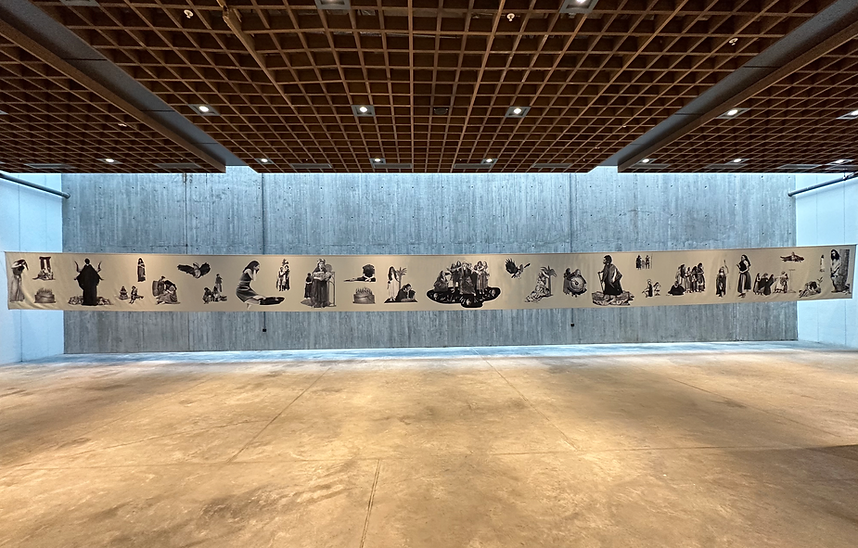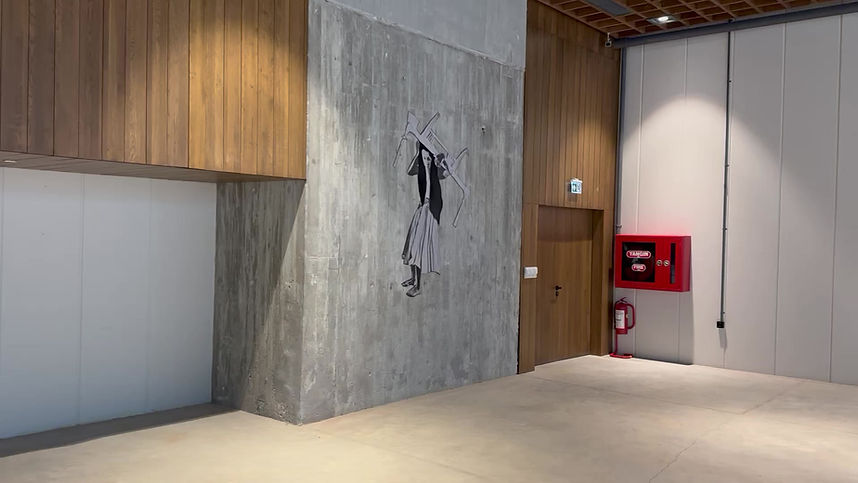BENAL DİKMEN
THE TROJAN WOMEN EXHIBITION
08-31 March 2023
Troy Museum Art Gallery, Çanakkale
In his tragedy The Trojan Women, Euripides (480-406 BC) depicts the fate of Trojan women who are left behind after their cities are sacked, husbands killed, and the surviving members of families taken away as slaves during and after the war. In other words, the Trojan war is told from the perspective of women. Drawing on both primary narratives and critical readings thereof enriched with feminist perspectives, Benal Dikmen takes a contemporary look at the situation of women in wars of all times: “It can be claimed that women’s work and warriors’ struggle are necessarily opposed to each other. The former is creative, meant to turn disorder into order while spinning wool into yarn. At the same time, the women who sustain life, feed and care for children, are engaged in textile production and child-rearing, performing the work necessary for the well-being and survival of their community. The warriors’ work in Troy, by contrast, is destructive. The death of the warriors in battle removes the care that women took to give birth to these men and to raise them from infancy,” she explains, bringing Trojan women into contemporary art.
Benal Dikmen thinks that mythological narratives demand to be transplanted to our age and that they should be reinterpreted according to today’s understanding, new art fields and techniques. She acts as a kind of “mediator” between mythology and contemporary art with this exhibition. In The Trojan Women, the first of a trilogy, she brings mythological narratives back to the agenda and invites the viewer to examine the times we are living in from a gender perspective.
Curator
Nergis Abıyeva

The Trojan Women, 130 cm x 200 cm, digital print on fabric

The Trojan Women serial, 2.000 cm x 140 cm, digital print on fabric

The Trojan Women serial, 130 cm x 200 cm, digital print on fabric, decoupage




The Trojan Women serial, 31 cm x 40 cm, collage and photo on handmade paper




The Trojan Women serial, 31 cm x 40 cm, collage and photo on handmade paper
INFECTING THE CITY 2017
Infecting the City, 2017. Artists Shortlist, Cape Town, South Africa.
The Concept of the Work:
Hesiod tells us that there was only Chaos in the beginning. Later, out of the Chaos, “wide flank” Gaia (Earth) and Eros emerged. Soon after, Gaia created an entity equal to itself. The starry sky surrounding it was the Uranus. From this cosmic holly marriage, the second god generation, the children of Uranus were born. These were six male Titans, six female Titans, three one-eyed Cyclops, and three Hecatoncheires.
This extreme birth that sometimes led to monstrosities resulted in putting them back to the womb of the Mother Earth (Gaia) by Uranus, who hated his children since their birth.
This part has been interpreted differently by researchers who deal with various mythologies. However, all of them believe that Uranus could never tolerate his children who “were not like him.”
My work is based on the analysis of the concept of “the other.” Different areas of interest such as religious belief, race, gender, sexual orientation, and physical disability can lead to “otherization processes.” However, in today’s world, in systems that have adopted the reality of multiculturalism, democracy is defined as “the recognition and internalization of the other.”
What Will Happen During the Display of the Work?
My work, the draft of which you see in the attachment, will be an installation made of various materials such as wood, cloth, and filling materials (1.5 m x 2.0 m x 2.5 m). The techniques used are collage, print, etc. My work will be an interactive work open to the participation of the viewers. During the exhibition, viewers can touch it, change the places of the modules, and open the cloth under it. In addition, the viewers can lift up the cloth and can take one of the sculptures hidden under it as a gift.

FORTE SANGALLO PROJECT
Nettuno, Rome, Italy, 8-20 November 2016
In this project, I have placed clothes and paper collages in different sizes in harmony with the boards in the rooms based on mythological and historical narratives through Nettuno city where the exhibition was held and the city’s historical castle, Forte Sangallo, which is the exhibition space. I have reproduced my and Giulia’s stories through the mythological stories of Neptune, the city’s god, and the Ottoman Prince Cem Sultan, whose paths crossed with the Borgia family, who once owned the castle, by keeping track of historical narratives, oral traditions, mythological stories, and the keywords of cooperation and coincidence.
The Roman artist Guilia Rioandelli and the Turkish artist Benal Dikmen, who respectively won the second and third places in the 5th Anzio and Nettuno modern art Biennial Shingle 22J designed and organized by L'associazione Culturale 00042 and Andrea Mingiacchi, opened their solo exhibitions.
In their co-work, Dikmen’s work consists of paper collages which represent the pagan figures and symbols attributed to the god Neptune, who the city was named after, getting inspired by historical-narrative events that are embedded with cultural references. Ripandelli’s graphic plates instead represent the plans and cross-sections of the castles and mosques created by getting inspiration from Antonio da Sangalio the Elder, who is the pioneer of “modern fortification” and the architect of the Ottoman Empire, Sinan the architect. The works of the Roman artist masterfully gets into interaction with Benal Dikmen and Forte Sangalio di Nettuno’s architecture, and with their history and historical attraction, they serve as an integrative and perfect scenography for the works exhibited.
Elisabetta Civitan
Curator

Cantarella, 2016, 140 x 200 cm, collage

Left: Scatter, 2016, 170 x 185 cm, digital printed collage; right: Naval War, 2016, 245 x 170 cm, digital printed collage

Encounters, 2016, 15 m x 1,50 m, collage with Giulia Ripandelli
3. RUHR BIENNIAL PROJECT
The Ruhr region is a very important industrial area of Germany. It is aiming to become also a great complex of cities of science, technology and culture without neglecting their industrial patrimony. The region is also known as a gigantic area where a multicultural and interactive community is well established. In this context, some collages made out of images inspired from the Ruhr Museum was to be exhibited in the interior and exterior parts of the Marxloh Centre Mosque in Duisburg, chosen as the space in which the artistic reminiscences of the region would meet its present identity. But a problem arose: Originally according to the Muslim religion, the representation of living beings - plants were not considered so - was banned. Therefore, the project could not get a welcome from some milieus. So following the hint given by Ibn Abbas, a theologian from the 7th century, to an artist, the works to be exhibited were transformed. The theologian had advised the younger man so: “You have to decapitate your living beings and give them flower appearance .” Thus living being depictions are authorized to be exhibited on the mosque walls and partitions without problem. The work is composed of two layers. In the first one there are 36 collages of 30 x 21 cm. They all are hand-cut on metal-colored cardboard. My inspiring sources are various works of art exhibited in the Ruhr Museum. The second layer too has 36 works, inspired from medieval Islamic plant patterns. They have the same dimensions as the first ones, and all are hand-cut on black art paper. Thanks to the correspondence of these two layers we obtain a new image composed out of Occidental and Oriental traditions. As for the application on the tangible level, I am planning to link the separate metallic plates according to the laser cutting method.


Panolar (36 adet), 2015, 30 x 21 cm
V. SHINGLE 22J BIENNIAL PROJECT
The miniature entitled Sûrname-i Vehbî (1720) exhibited in the Topkapı Palace Museum exposes an indirect information of ‘eating’ in its relation to the political power: When the Janissaries (Ottoman soldiers) help themselves to the saffroned pilaf offered them by the Sultan, we understand that they are satisfied with the government, the social order is intact; when they refuse it, we know that they are in conflict with the political power, a mutiny is under way.

The Fact of Eat as an Index of Political Power, 2015, 35 x 50 cm, collage
WORKS

No name, 8 pieces, 2015, 60 cm x 42 cm